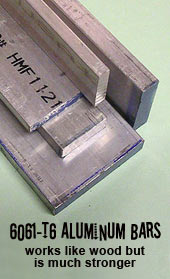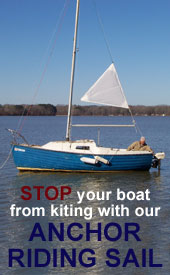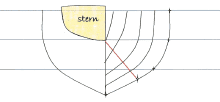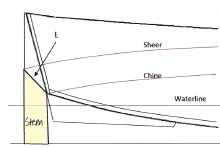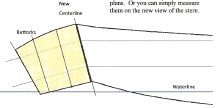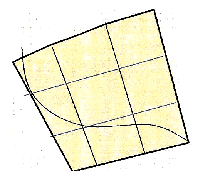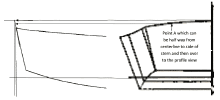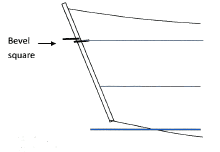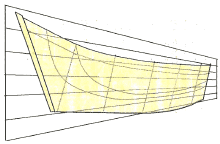
 Custom Search
|
| sails |
| plans |
| epoxy |
| rope/line |
| hardware |
| canoe/kayak |
| sailmaking |
| materials |
| models |
| media |
| tools |
| gear |
| join |
| home |
| indexes |
| classifieds |
| calendar |
| archives |
| about |
| links |
| Join Duckworks Get free newsletter CLICK HERE |
|
|
| Out There |
by Paul Austin - Dallas, Texas - USA Lofting Today - Part Two |
 |
| Part One- Part Two - Part Three - Part Four - Part Five Now for a curved hull. The method is the same, only with a curve we need more points. This means different lines and more nails around which to bend a batten to draw that curve. Some designers use a stiffer batten for the sheer than the other chines or frames. With round bottomed boats the sheer is a significant strengthening member. Now for the same boat, with new lines. I'll put the frame shape in first as you see here with its curved sides. And below the blue waterlines, each one 6 inches above the lower one. The very top water- line is probably not necessary, but I put it in for the bow.
Here with the curved frame in.
we have four points where we can drive nails, laying our batten around the outside of the nails. But that might not be enough. He might put in a diagonal for another point below the first waterline to take that real curve. So, here is the diagonal in an enlarged view.
A diagonal always comes off a waterline to establish a new point. They aren't always the same angle down. It depends on where the best place is to put a nail to get the curve right. That means how the batten will bend as well as how the frame curves. Lapstrake or carvel frames are part experience and part feel for wood. The computer can't always tell you how much stress is on a certain point of a certain frame, you'll just have to feel it with your fingers. Our last items are the only ones requiring any description. They are the stem where it connects to the keel and the stern transom. We'll got back to the profile in which to draw in the stem and keel, showing their thickness. The original line in black was the outside of the stem. The new line in blue is the outer stem.
The exact shape of the stem is taken by measuring from the perpendicular to the stem on the waterline. I've shown one waterline to keep this drawing clear, but you should take at least 3 measurements. When you draw in the stem thickness-shown by the blue line-I'd just get a 1x4" pine and make that the stem thickness. If you work from plans, the stem thickness will be in the table of offsets, or it will be drawn in on the hb plan, as I have here. This is a great place to say, this is why measuring accurately is critical. As Ken Simpson says on his plans, measure twice and cut once. Now we will project the stem thickness onto the plan view. From the image above we see that the stem is made from 2x4" wood, so the stem thickness in the plan view will reflect that. In fact, the stem will show up on frame drawings as rectangles, especially if the stem widens as it goes on aft.
One of the goofy aspects of boat design is that where the stem meets the keel should be strongest part of the boat. This is where the pounding comes. But in small boats this is often where the boat is at its' lightest. This brings us to the stern. We start with the perpendicular and the baseline. With a scale we can measure the length of the stern and the angle off of vertical in which it sits. We need to notice that the hb of the stern does not match sheer and chine lines which are on the profile. That's because the centerline of the hb was 1/2" below the profile keel. This gives us room to measure accurately.
Going from profile to hb view gives us the widths of the stern at the chine and sheer and the angle in which the stern will hang but it does not give us the length of the sides, since the hb view is below the stern not facing it. So we need to do something else to get the length (L). With this straight-sided skiff the length (L) cannot come from the body plan as the dimensions there come from the tilted view of the profile. So what we do is use the profile view of the stern as a centerline and then draw off that centerline. The measurements off the new centerline can come from offsets if you're working from plans. Or you can simply measure them on the new view of the stern.
Again, the method is not difficult. Even complicated wineglass sterns on Whitehalls and lapstrake boats are done this way. Now we'll finish up this short run through lofting a simple skiff by showing how the slight arc of the Atkin stern top is created. It amounts to drawing lines from the plan view to the profile view and down to the hb view.
Point A - which can be half way from centerline to side of stern and then over to the profile view.
We'll begin by picking a point on the Atkin stem curve. Then we project it across to the profile view and then on down to the hb view. From there we can draw the curve. I've exaggerated the curve on the hb view so it can be seen better. Now we'll finish this off with bevels. I have plans to the Bolger Pointy Skiff on which the bevels are all drawn full-sized, off to one side so they can be seen easily. With plans, every bevel can be shown on the lines. With the bevel where the bottom meets the stern transom, you can put a bevel square on the plans, use a protractor or even a folded piece of paper. If you use a protractor, only get the angle off the 90 degree line. A bevel is an angle off of square. This tells you where to set a table saw. The standard practice is to mark the number of degrees either as 25-degrees-U (for under when you're cutting back on the wood) or 25-degrees-S (for standing when you're cutting out) from where you mark the measurement line.
With bevels, you can put a bevel square, a protractor or even a cut piece of paper. For the bevel between the stern transom and the bottom chine, the angle will be true. What you see on the plans will work. But for other bevels, since the sides flare and the transom is raked an adjustment will have to be made. With transoms, the bevels on the transom top and sides need to be cut first. You can lay the bevel square along the waterline of the stern, realizing it then won't be parallel to the waterline on the sides. That's all right. We're getting the bevel, so it needs to be on one waterline, not two. This is due to the rake of the transom. Now you know why square ended boats are called easy to build.
Now that we know how to put lines in, what they're called, what they're for, we can see how designers put all of this in a table form. Some builders prefer to work from a table of offsets only. This is all right providing you look at the lines you've drawn from the offsets. As John Gardner once said, it's better to create beauty than to possess it. While numbers aren't pretty to most of us, the lines they describe can be.
Paul This is Paul's Blog: https://crossingthoughts-paul.blogspot.com.au P.S Paul now writes with Mike John on the History of Science HQ: Paul is also publishing his books on Amazon. *****
|
|
